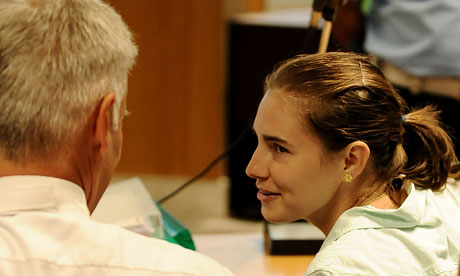Italian prosecutors attack experts who criticised forensic evidence used to sentence Knox to 26 years for murder
Amanda Knox speaks to her lawyer Carlo Della Vedova in court on 24 September. Photograph: Mario Laporta/AFP/Getty Images
Seeking to uphold Amanda Knox's conviction for murder, the prosecution on Saturday mounted an all-out attack on the independent, court-appointed experts who have poured scorn on the forensic evidence used to sentence her to 26 years in jail.
Manuela Comodi, the third and last prosecutor to address the court hearing Knox's appeal, noted the experts were both professors of forensic science, rather than practising investigators.
And she asked the jury of five women and one man: "Would you entrust the wedding reception of your only daughter to someone who knew all the recipes by heart but had never actually cooked?"
According to her relatives, the experts' damning report, submitted in June, has given the Washington university student new hope, making her cautiously optimistic she will be freed by the court later this month or early next. She has been joined in her appeal by her former Italian boyfriend, Raffaele Sollecito, who was given a 25-year sentence.
But, said Comodi, the experts had put up an "embarrassing performance". She told the two judges and the jurors (technically, lay judges) that the two Rome university professors had been given an assignment "that they did not know how to fulfil, betraying your trust".
A third man, Rudy Guede, whose presence at the scene of the murder was only discovered after their arrest, has also been convicted of murdering 21 year-old Kercher in 2007.
The prosecution maintains that Guede, a small-time drugs peddler from the Ivory Coast, joined the others in a frenzied, narcotics-fuelled sex game that ended in tragedy after the British woman resisted.
The clinching evidence at the trial of Knox and Sollecito included a trace of his DNA on Kercher's bra clip and a knife, which the prosecution claimed was the murder weapon, bearing the DNA of both the defendants and their alleged victim.
The experts found that Sollecito's DNA could have reached the bra clip, which was only identified and bagged 46 days after the discovery of the body, by a process of contamination. They said the third trace of DNA on the knife, which was in Sollecito's kitchen, was too faint to be ascribed confidently to Kercher.
But, said Comodi, the original analysis had been carried out by police forensic experts whose competence was internationally recognised. And the defence had failed totally to show how the contamination of the bra clip might have occurred.
http://gu.com/p/3263m/tf

